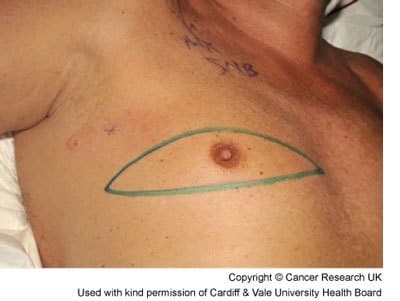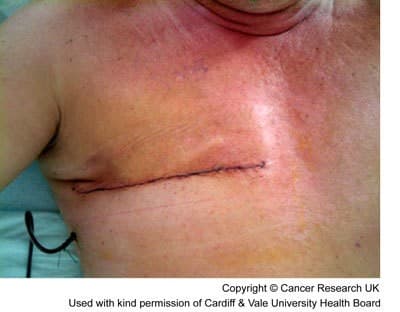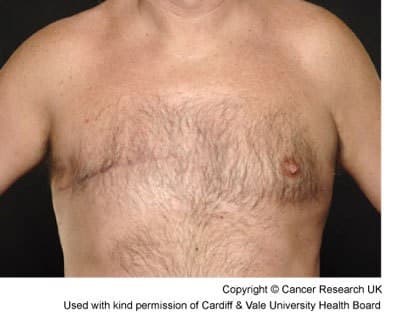Types of breast cancer and related breast conditions
Less than 1 in 100 (less than 1%) breast cancer cases in the UK are in males. It is a rare cancer for men.
There are some similarities between male breast cancer and female breast cancer. But there are also important differences between the 2. The most common type of breast cancer in both women and men is called invasive breast cancer - No Special Type (NST). You may also hear it called invasive ductal carcinoma NST.
Men can also develop rarer types of breast cancer but these are very rare. They include:
ductal carcinoma in situ (DCIS)
invasive lobular cancer
Paget's disease of the breast
Find out more about these types of breast cancer and related conditions
Anything that increases the risk of getting a disease is called a risk factor. Different cancers have different risk factors. Having one or more of these risks factors doesn’t mean that you will definitely get breast cancer.
The risk factors are similar to the risks factors for female breast cancer. They include:
getting older
being exposed to x-rays and radiotherapy
having a family history of breast cancer or an inherited breast cancer
Read about these risks factors on our risks and causes for breast cancer page
Other risk factors are specific to breast cancer in men. These include having high hormone oestrogen levels and a rare condition called Klinefelter's syndrome.
All men produce small amounts of the hormone called oestrogen. This is perfectly normal. But high oestrogen levels in men have been linked to an increased risk of getting breast cancer. High oestrogen levels can occur in men who:
are obese
have liver conditions, such as cirrhosis
have thyroid problems
use prohibited drugs such as marijuana
Klinefelter's syndrome is a rare genetic condition where a man is born with an extra female . This means that he has XXY chromosomes instead of XY. This leads to a hormone imbalance where the body makes less testosterone.
Men with Klinefelter have an increased risk of developing breast cancer. But this doesn't mean that they will definitely get it.
The most common symptoms for men with breast cancer include:
lump in the breast that is nearly always painless
oozing from the nipple (a discharge)
a nipple that is pulled into the breast (called nipple retraction)
swelling of the breast (gynecomastia)
a sore (ulcer) in the skin of the breast
lump or swelling under the arm
a rash on or around the nipple
If you have any of these symptoms it is important to go to your GP straight away. Finding a cancer early gives the best chance of successful treatment.
You usually have an ultrasound scan of the breast and the under your arm (axilla). You might also have a breast x-ray (mammogram).
If these tests show an area that could be cancer, you have a sample of tissue taken (biopsy). This is then examined under a microscope by a specialist. If these tests show that you have breast cancer, you might have other tests to see whether the cancer has spread. These tests include:
an MRI scan
a bone scan
a CT scan
Find out about breast cancer tests
Treatment for breast cancer in men is similar to the treatment for women. The treatment you have depends on a number of factors. This includes:
the size of the cancer and whether it has spread (the stage)
how abnormal the cells look under the microscope (the grade)
whether the cancer cells have receptors for particular hormones
your general health and other medical conditions you might have
Your team will discuss the pros and cons of the treatment options with you. Do ask questions so that you understand which treatments you are being offered, and why.
You usually have surgery to remove the whole breast (mastectomy) including the nipple. Most men do not have a lot of breast tissue, so it isn't usually possible to leave any breast tissue behind. Sometimes the surgeon also removes part of the underlying muscle if it is close to the cancer.

Your surgeon might also remove some of the lymph nodes from the armpit. They send the nodes to the laboratory to see if they contain cancer cells. Or the surgeon might check the lymph nodes closest to the breast using a procedure called sentinel node biopsy.
This photo shows the marks made before a mastectomy operation.

The chest 1 day after a mastectomy operation.

The same man 3 months after the operation.

Once treatment has finished your surgeon can make a new nipple for you if you want it. You need to wait a few months after the mastectomy to allow any swelling to go down and the wound to heal.
The surgeon might be able to create the shape of a nipple using the skin from another part of your body such as the groin. The new nipple won't have any feeling, and won't respond to touch or temperature.
Other options include tattooing a new nipple and areola onto the chest. Or you can use stick on nipples. Your breast care nurse can tell you where to get them.
You might have chemotherapy before and after surgery.
Chemotherapy before surgery is called neo adjuvant treatment. It can help to shrink the cancer before surgery.
Chemotherapy after surgery helps to reduce the chance of the cancer coming back or spreading.
You may have radiotherapy after surgery. This lowers the risk of the cancer coming back.
Your specialist will arrange receptor tests on your cancer cells when you are first diagnosed. If your cancer cells have hormone receptors, it is called hormone receptor positive breast cancer.
You usually have hormone therapy for hormone receptor positive breast cancer. This can help to reduce the chance of the cancer coming back. You usually take hormone therapy drugs for at least 5 years.
The most common hormone therapy for male breast cancer is tamoxifen.
You may also have targeted cancer drugs if your cancer cells have receptors for certain proteins. The most common targeted drug for breast cancer is trastuzumab (Herceptin).
Find out more about treatments for breast cancer
Some men are diagnosed with cancer that has already spread. Or the cancer might come back and spread some time after treatment. This is called secondary breast cancer, advanced breast cancer, or metastatic breast cancer.
In this situation your doctor might recommend:
chemotherapy
hormone therapy
targeted cancer drugs
radiotherapy
a combination of these treatments
Read about treatment for secondary breast cancer
You have regular check ups after treatment for breast cancer. How often you have check ups depends on your individual situation.
It’s important to remember that you can contact your doctor or specialist nurse if you notice a new symptom or have questions. You can also speak to your GP.
Read more about breast cancer follow up
It is difficult to organise trials and research for rare cancers. For example, it can be hard to recruit enough men with breast cancer within a certain time.
Some breast cancer trials are recruiting women only. But increasingly, treatment trials are recruiting men with breast cancer as well as women.
Find breast cancer trials on our database
It is very common to hear about breast cancer in women. But it isn't common to hear about it in men.
Coping with a diagnosis of cancer can be difficult, both practically and emotionally. It can be especially difficult if you have a rare cancer. Being well informed about your cancer and its treatment can make it easier to make decisions and cope with what happens.
As male breast cancer is rare, you are likely to have treatment in a large, specialist hospital. So your consultant may know other men with breast cancer you could talk to.
Cancer Research UK’s discussion forum is a place for anyone affected by cancer. You can share experiences, stories and information with other people who know what you are going through.
You can phone the Cancer Research UK nurses on freephone 0808 800 4040. The lines are open from 9am to 5pm, Monday to Friday. They will be happy to answer any questions that you have.
There are a number of charities and support organisations that can help you cope with breast cancer.
Last reviewed: 27 Jun 2023
Next review due: 27 Jun 2026
You have a number of tests to check for breast cancer. This includes a breast examination, a mammogram, a biopsy and scans.
There are different types of breast cancer and breast conditions, including breast cancer in men, and conditions related to breast cancer. Find out more about the different types.
Treatment for breast cancer depends on a number of factors. Find out about breast cancer treatments, where and how you have them, and how to cope with possible side effects.
Get information about how doctors stage and grade breast cancer. In the UK, doctors use the TNM system to stage breast cancer. You may also be told about the number staging system.
These can help to find out the type of breast cancer you have and look for proteins (receptors) on the surface of breast cancer cells. They can also look at cancer genes (tumour profiling tests).
Find out about breast cancer, including symptoms, diagnosis, treatment, survival, and how to cope with the effects on your life and relationships.

About Cancer generously supported by Dangoor Education since 2010. Learn more about Dangoor Education
Search our clinical trials database for all cancer trials and studies recruiting in the UK.
Meet and chat to other cancer people affected by cancer.
Questions about cancer? Call freephone 0808 800 40 40 from 9 to 5 - Monday to Friday. Alternatively, you can email us.